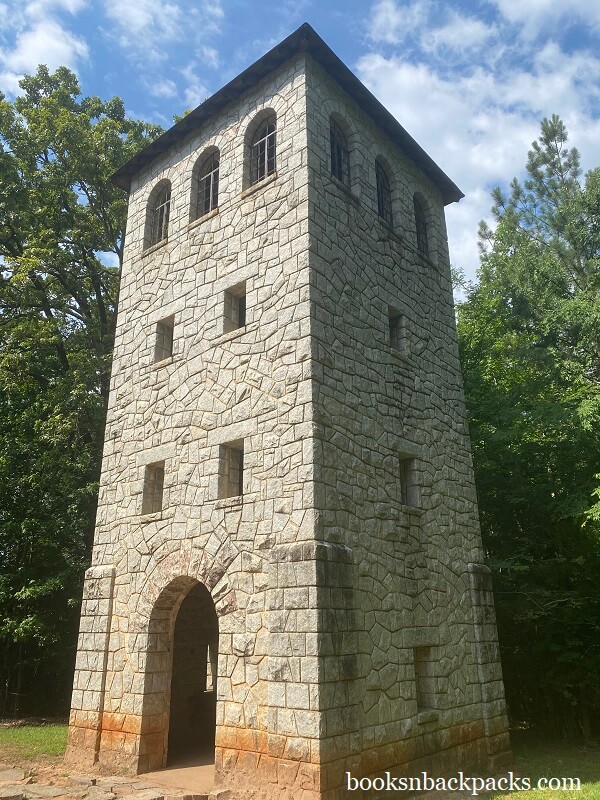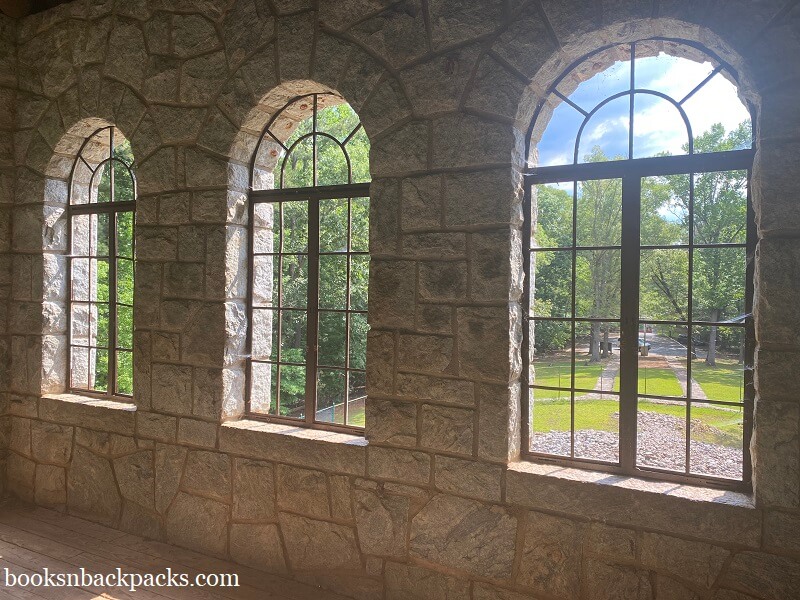Rock Eagle Effigy Mound: Explore A Hidden Gem in Georgia
If you’re in central Georgia, stop in Eatonton to visit the unique Rock Eagle Effigy Mound. You won’t want to miss this fascinating (and free) 2000-year-old site!
Eatonton, Georgia was founded in 1807, but Native Americans had been living in the area for over 12,000 years when white settlers arrived. Rock Eagle is a testimony to this ancient past.
In this post, you will learn everything you need to know about Rock Eagle and how to visit – and see lots of photos. You won’t regret exploring this fascinating hidden gem!
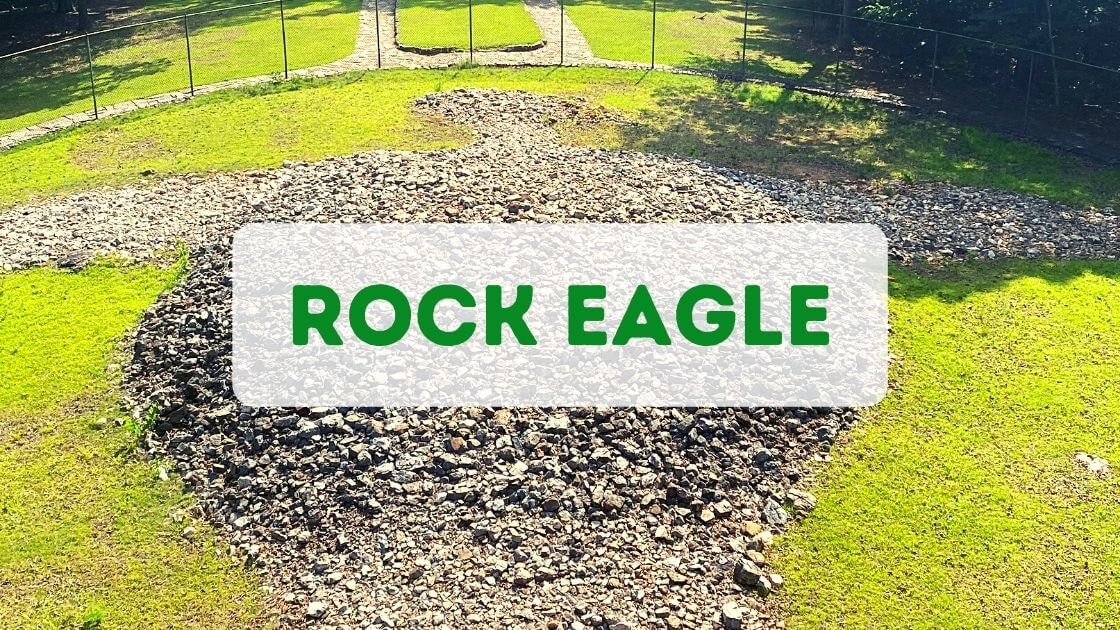
Rock Eagle Effigy Mound: History & Description
What is the Rock Eagle Effigy Mound?
In Putnam County, about an hour southeast of Atlanta, thousands of milky quartz rocks form a mound in the shape of a eagle. Or at least, we think it is an eagle. It is impossible to know for sure.
The eagle’s wings extend 120 feet from tip to tip, while the distance from head to tail is 102 feet. At the highest point, the center of the eagle’s chest, the mound reaches 8 feet.
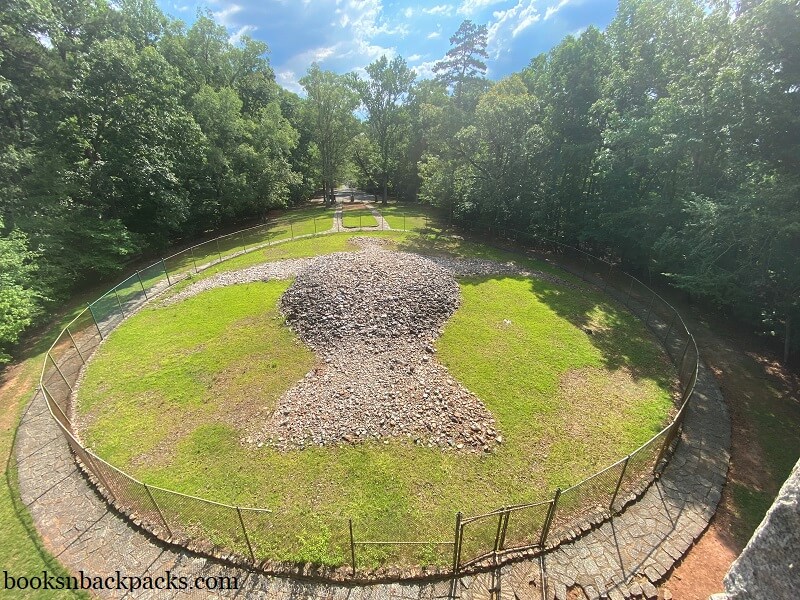
Archaeologists aren’t sure exactly how old Rock Eagle is. Estimates range from 1,000 to 3,000 years old. But one thing is clear: these rocks have been there for a very long time.
According to some scientists, Rock Eagle dates to the Middle Woodland Period (100-300 CE). That would make the site almost 2,000 years old.
It is unclear what the purpose of the effigy was. Some archaeologists believe that it was a burial site; excavations have uncovered some cremated human remains. Others suggest that it was a religious site. Perhaps the eagle was a message for the gods, since you can only appreciate its shape from above.
Rock Eagle is one of only two surviving effigy mounds east of the Mississippi River. This makes it a truly unique place to visit in the southeast. (If you are wondering, the other effigy mound is also in Putnam County – more about it below.)
What is an effigy, anyway?
Are you wondering what an effigy is? The term confused me, too, because I typically associate it with negative connotations like burning someone in effigy.
However, an effigy is technically defined as an image or representation of something. This makes sense when you consider that “effigy” comes from the Latin effingere “to form or fashion”.
According to Merriam-Webster, an earlier sense of “effigy” referred specifically to likenesses shaped out of stone. And that is what is meant with the name “Rock Eagle Effigy Mound.”
And now let’s talk about what it’s like to visit Rock Eagle!
Visiting the Rock Eagle Effigy Mound
Getting to Rock Eagle
Rock Eagle is in Putnam County, Georgia, near the city of Eatonton. The site is incorporated into the Rock Eagle 4-H Center, which is managed by the University of Georgia.
You can easily access Rock Eagle by car via U.S. Route 441. Once you are on the grounds of the 4-H center, helpful signs guide you to the effigy itself. (The effigy doesn’t have its own address, but it does appear in Google Maps.)
There is free parking right next to the mound, and admission is free as well. Just make sure you come after 7:30 am and before dusk, since the center does close for the night!

Exploring Rock Eagle
Once you have parked your car, it is time for the adventure to begin! A stone path leads from the parking lot to the mound. The Rock Eagle 4-H Center just renovated the site to make the path ADA-accessible, so you can use wheelchairs and strollers with no problem.
On the way, you pass signs discussing Rock Eagle and its history. There is also information about Rock Hawk, the only other surviving effigy mound east of the Mississippi River, and possible other effigies in Putnam County.
A chain-link fence surrounds Rock Eagle for preservation purposes. But don’t worry – you can still get a good look at the site.
The very best view is from above, where you can truly appreciate the effigy’s shape. In the 1930s the Civilian Conservation Corps (C.C.C.) built a tower to allow visitors to get a bird’s-eye view.
Follow the path around the mound to the tower. Then climb the six flights of stairs to the top, and you will have the best possible view of Rock Eagle. The tower is too old to have an elevator, so the only way up is to climb the stairs.
My mother and I spent around thirty minutes in the tower simply admiring the view. The forest closes in all around the mound, creating a peaceful natural setting for the effigy. You can gaze at the rocks and think about the centuries upon centuries that have left them untouched.
Note on accessibility: As I said above, the 4-H Center recently added an ADA-compliant path around the effigy mound. (Note that the photos in this post were taken before this renovation.) But there is no way to appreciate the mound from above without climbing the tower stairs.
Pro Tip: Arrive at the site in the early morning to enjoy some solitude. Remember, Rock Eagle is at a 4-H center – and as the day goes on there are a lot of 4-H campers around, especially in the summer.
Things to do near Rock Eagle
As I have mentioned several times above, there is another effigy mound in Eatonton, Georgia: Rock Hawk. This mound is not in quite as good shape as Rock Eagle, but you can still see and appreciate its outline.
Rock Hawk is located on the shores of Lake Oconee, right next to the Historic Piedmont Scenic Byway (G.A. Highway 16). The site also includes a tower, so you can get an aerial view, as well as 30 miles of educational trails through the wetlands.
It is a 25-minute drive from Rock Eagle to Rock Hawk. If you have some extra time, kill two birds with one stone (no pun intended, I promise!) and visit both of the surviving effigy mounds east of the Mississippi.
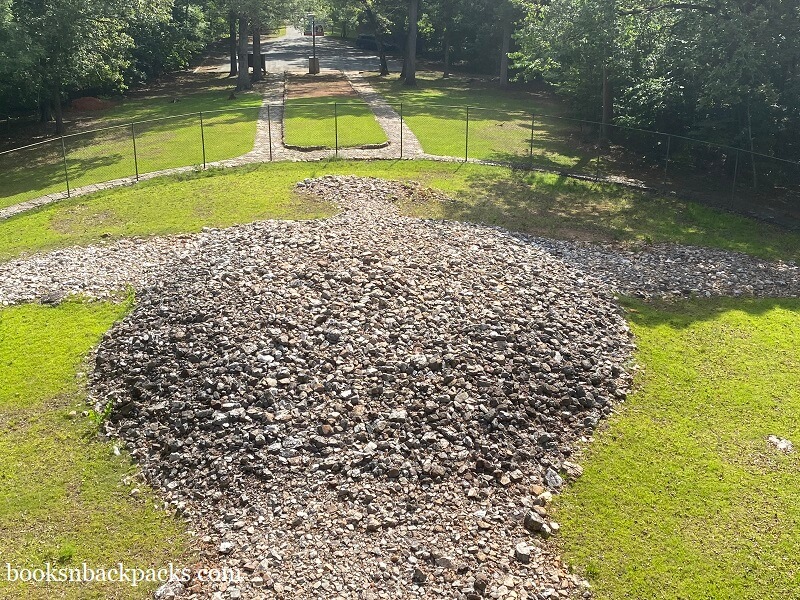
Rock Eagle FAQs
Is Rock Eagle open to the public?
Yes! The Rock Eagle Effigy Mound is open to the public from 7:30 am to dusk every day. Very occasionally the site needs to close for maintenance; you can check for updates on the Rock Eagle 4-H Center’s Facebook or Instagram.
Parts of the 4-H center are reserved for the use of 4-H camps and other groups, but the effigy itself is always open to everyone.
Do you have to pay to visit Rock Eagle?
No, it is entirely free to visit Rock Eagle Effigy Mound.
Where is the Rock Eagle Effigy Mound?
Rock Eagle is in Eatonton, Georgia. It is located 70 miles – an hour’s drive – southeast of Atlanta. Other nearby cities include Athens (45 miles north), Macon (50 miles south), and Augusta (90 miles east). Rock Eagle is a great day trip from any of these locations.
Who owns Rock Eagle?
The effigy is part of the Rock Eagle 4-H Center, which is cared for by the University of Georgia. But, as I said above, the effigy is free for the general public to visit.
In addition to the effigy, the 4-H center includes Rock Eagle Lake as well as cabins, a dining hall, and other facilities used by the 4-H programs. 4-H is a nationwide organization designed to teach youth important life skills, and the center also offers programs for the whole community.
What are the measurements of the Rock Eagle effigy?
From wingspan to wingspan, Rock Eagle measures 120 feet. From head to tail it is 102 feet. Rock Eagle’s highest point is at the center of the eagle’s chest, where it is 8 feet tall.
Who built Rock Eagle?
We don’t know who built the Rock Eagle effigy mound or why. Archaeological surveys of the site have proved inconclusive; all we can really say is that Native Americans built the mound around 2,000 years ago. Some scholars associate Rock Eagle with the Hopewell Culture, but this is conjecture.
When Europeans arrived in the area in the early 1800s, the land belonged to the Muscogee (Creek) Nation. White settlers received the land in a lottery in 1805 and the Muscogee were forced to move west to Oklahoma.
Final Thoughts
We may never know exactly what Rock Eagle meant to its builders, but we can still appreciate the magic of the location. We can still be struck by the amazing diversity and creativity of humanity. Not to mention, we receive an important reminder that there were many cultures flourishing in the Americas before the arrival of Europeans.
If you have the opportunity, you should definitely visit the Rock Eagle Effigy Mound and learn a bit about Georgia’s prehistoric inhabitants. If you want to spend more time in the area, you can hike on trails around the nearby Rock Eagle Lake. There are also picnic tables available down the road from the mound.
Rock Eagle is one of Georgia’s true hidden gems. Most Georgians haven’t even heard of it, which is a real shame. But now you know about this unique north Georgia roadside attraction! So next time you’re in the area, take a step into the distant past and admire Rock Eagle.
Are you interested in Native American sites in Georgia? If so, you may also enjoy touring the earthen mounds at Etowah (in Cartersville, GA) or visiting the former Cherokee capital at New Echota (in Calhoun, GA).
If you want to go farther afield, then head to Cherokee, North Carolina for a historic mountain getaway. You can learn about the Cherokee’s past and present in the beauty of the Great Smoky Mountains!




